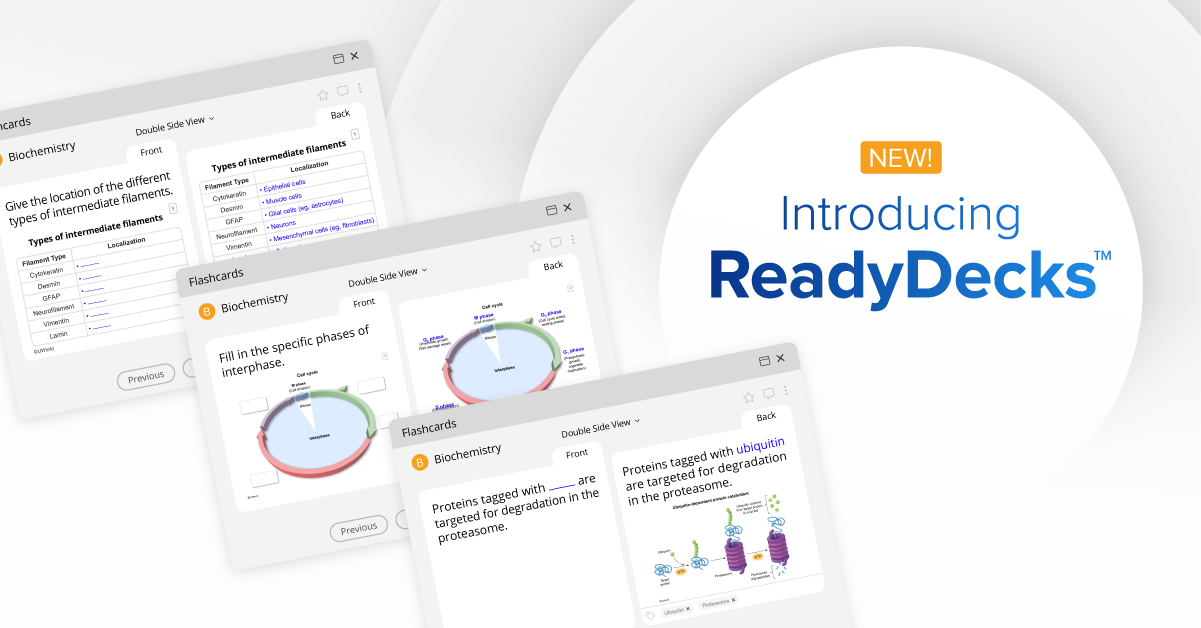By: Abi Felsted, M3
That first year zooms by, followed by a summer to relax before digging deeper into the sciences as a second-year medical student. Then it’s time for USMLE Step 1 Exam. The culmination of thousands of study hours, dozens of exams, and all your organ-system blocks tested in 280 questions.
At my school, it’s standard to finish second year in April, then spend four to eight weeks in a dedicated study period (which we call “dedicated” for short) to take Step 1 before third-year clerkships begin in June. In this article, I share how I used my resources before and during dedicated, how I paced myself on exam day, and what was most important for ultimately achieving my goal score!
Before Dedicated
I previously shared how I used UWorld during M2 to study for my medical school’s systems-based blocks. Using UWorld to solidify my knowledge throughout each organ block, I got through about 35% of the Step 1 questions before finishing M2. It was actually surprising how much stamina and time it took to do and review even 10-15 questions at a time during that year. But once my dedicated started, I was so grateful I had started using the questions the year before. It meant that I was already familiar with the UWorld platform and how to approach questions. Plus, I knew how to budget my time for the explanations, and I’d already built up a reasonable amount of stamina for practice tests.
My approach for reading every practice question:
- First, I read the last sentence of the paragraph where the question is posed,
- Then I read the answer choices.
If I have enough information to answer (around 5-10% of questions), I skip the stem. If I need more information, I read the paragraph once through thoroughly. - I then reread the question in the last sentence of the paragraph and then
- Answer the question.
I love this approach because it saved me a lot of time on questions with long stems (sometimes, all that information wasn’t needed to answer the question!). Pre-reading the answer choices also alerted me to the general concept of the question. Finally, it standardized how I approached each question, helping me gather the information in a systematic way so I made fewer mistakes.
Other pro tips for the UWorld platform:
- When creating a test, you can expand “Systems” and select sub-topics for a more tailored review.
- In the test interface settings, you can place the explanations side by side with the question while reviewing.
- Also, in the test interface settings, you can enlarge the text by using the + next to “Font Size.”
Diagnostic tests before dedicated:
Before starting dedicated, I took two practice exams—one from an external company (score: 206) and one from the NBME (score: 173). Since my scores were vastly different, I decided to assume I was closer to the NBME score and prepare for a lot of studying. My ultimate goal was to score >220.
During Dedicated
I initially planned to have my dedicated study period last six weeks, from the moment I finished M2 year to the time I took Step 1. However, I ended up changing my Step 1 date a couple of times to get the ideal location/date. Ultimately, my dedicated period for Step 1 was exactly seven weeks. That was the perfect amount of time for me to truly ensure that I was learning what I needed to, without spending so much time as to make me crazy!
In the days leading up to dedicated, I spent a lot of my time trying to create the perfect review schedule. Unfortunately, this didn’t suit my personality, so I decided to take a more realistic approach. In the end, my dedicated schedule revolved around doing UWorld questions and practice tests, with only about 10% of my time spent on content review.
Why did I do this?
- I believe I struggled on the MCAT because I did way too much content review and not enough questions.
- My school gave me a solid foundation of knowledge before dedicated, and I knew I needed to get through as much practice as possible.
- I am not super-organized. That self-awareness meant I needed to create a realistic schedule for me. It was a lot simpler to have a daily plan of doing three 40-question blocks of UWorld than trying to fit in a specific amount of content.
My “daily grind”:
- Day 1 of dedicated: I reset my UWorld account.
Since I had done UWorld questions during M2, I completely reset my QBank. I went in ready to tackle the questions I had never seen and thought I would breeze through the ones I had seen before. However, it turned out that I genuinely remembered only one or two questions that I had seen before, so all the questions ended up being great practice. - Days 2-30 of dedicated: I did three 40-question blocks of UWorld every day.
This wasn’t easy. In fact, it was really hard. I was shocked at how challenging it was to sit and focus for so long every day. However, I grew more efficient with each passing day. It is important to note that I chose to do every single block in Timed and Test mode. The real USMLE Step 1 exam wasn’t in Untimed or Tutor mode, so I didn’t believe in practicing in a way that was different from the actual test. I am glad I chose to do this; I suspect that my friends who only practiced in Tutor mode struggled quite a bit on the real exam because it was unsettling to choose answers and move on without seeing the solution immediately after.
My strategy for reviewing the question blocks did change a few times, but ultimately, my most effective approach was to ditch Anki and the idea that I needed to see all the questions again. Instead, I decided to do just one really solid review of the questions. After each practice test, using blank white office paper and colorful pens, I sketched out diagrams, wrote down why the explanation made sense, and drew out any images UWorld had. With this strategy, I never again missed questions on concepts I had already reviewed. - Days 31-47 of dedicated: I did two or three 40-question blocks of UWorld every day.
During the last few weeks of dedicated, I decreased the number of questions I did per day because I wanted to do some content review that I felt was important. For me, this meant getting through all of Pathoma (and doing chapters 1-3 twice), reviewing NBME images, and whiteboarding certain sections of First Aid (mostly biochemistry and immunology). I continued doing random blocks of 40 questions and did my best during this time to be more efficient at reviewing, taking around 90 minutes to get through a block of 40 questions. A few helpful tips I received were to set a timer, start by reviewing my “wrongs,” and commit to being done when time was up. The timer helped me avoid the temptation to go down rabbit holes when reviewing the blocks. - Day 48 of dedicated: Chill!
The day before my exam, I spent the whole day with my mom, simply relaxing and enjoying the day—no questions, no content, just mental clarity. I visited my testing center, found out where to park, and did some meditation. I was ready.
Practice tests during dedicated:
Naturally, I spent several days taking practice exams. My goal was to take a practice exam every week and ultimately take UWorld’s Self-Assessment 2 and the NBME Free 120 as a complete exam the week before the real test.
My schedule was as follows:
- Week 1: NBME 26 (score: 182)
- Week 2: UWorld Self-Assessment 1 (score: 222)
- Week 3: NBME 28 (score: 182)
- Week 4: NBME 27 (score: 201)
- Week 5: NBME 29 (score: 219)
- Week 6: UWorld Self-Assessment 2 and NBME Free 120 (score: 235 / 78%)
- Week 7: REAL EXAM!! And I hit my goal score! (>220)
What was the deal with the variability in my NBME scores? Honestly, I don’t know. The NBME exams felt difficult to navigate, I struggled with the random wording, and, frankly, I don’t think they were actually very similar to the actual test. Nevertheless, I still felt they were worth taking. The order was based on my advisor’s input about which ones were more challenging.
In my opinion, the tests most similar to Step 1 were the random blocks of 40 questions I did every day and the paired UWorld Self-Assessment 2 and NBME Free 120. Although it was really tiring to do a full seven-hour practice exam, I am really glad I did! It helped me feel more confident going into exam day, and I believe it built up my endurance.
On Test Day
Honestly, the day flew by. I was lucky to have a great testing center, but I had also packed a lot of snacks and brought an extra jacket in case it got chilly. I forgot my earplugs, but luckily, the test center had some for me.
I was placed in a little booth in the back corner of the room. Then, for eight hours, I poured every ounce of knowledge I had into the test. I stayed on track with my timing as I had for every UWorld block, and it genuinely felt like I was retaking UWorld Self-Assessment 2. The platform even looked identical to UWorld’s NBME interface.
For my first break, between blocks 1 and 2, I decided to stay in the room and do a two-minute breathing exercise. After every other block, I left the room for a 5-10 minute bathroom/jumping jacks break and grabbed a snack. I saved 20 minutes to use between the last two blocks, found a couch, grabbed some food, and watched a short Netflix show. This was quite nice because I felt invigorated and didn’t get the “last block sleepies” that I had experienced during practice tests.
The wait after Step 1:
It took me two weeks to get my score back (the timing is a bit different for everyone). What mattered most to me was being able to pass Step 1 and never look back! I know I couldn’t have done it without UWorld. I’m thrilled to be a third-year medical student considering surgery and realizing that I am genuinely confident applying with my score.
Final advice for Step 1:
To the incoming M2s, I know this is a daunting year and you aren’t sure what to expect. My best advice is to focus on your classes and aim to learn all the material being taught. Reinforce your studying throughout the year with USMLE Step 1 questions to practice with material from outside your home institution and ensure you can apply the foundational knowledge you’re learning. As you approach dedicated study, create a schedule early on with a rigorous plan to do questions alongside some content review. Trust the process, meet with an advisor, and know that you can do this. Get comfy with UWorld—you’ll be together for the long haul this year!
For more information, Try UWorld’s Step 1 QBank.




